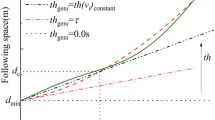Abstract
This research focuses on the attitude motion controller to improve the ride-comfort and handling capability of a vehicle simultaneously. The attitude tracking controller is designed to let the actual motion of the car body follow the ideally guided value, which is developed conceptually to eliminate lateral and longitudinal forces acting on passengers. The tracking control forces are computed based on the three predicted data proposed for the future ideal roll and pitch motions. In conventional ways, the car body leans outside around sharp turns because of the centrifugal force and it dives forward when braking and leans back when accelerating. However, the attitude tracking controller makes the car body skew inside at cornering, squat at braking, and dive at accelerating. Simulations are performed based on a four degree-of-freedom half car model and then the results show the great potential of the proposed approach.
Similar content being viewed by others
References
Cho, B. K., Ryu, G. and Song, S. J. (2005). Control strategy of an active suspension for a half car model with preview information. Int. J. Automotive Technology 6, 3, 243–249.
Gaspar, P., Szaszi, I. and Bokor, J. (2005). Reconfigurable control structure to prevent the rollover of heavy vehicles. Control Engineering Practice, 13, 699–711.
Goodall, R. M. (1999). Tilting trains and beyond-The future for active railway suspensions: Part 1. Improving Passenger Comfort, J. Comput. Control Eng. 10, 4, 153–160.
Malekshahi, A. and Mirzaei, M. (2012). Designing a nonlinear tracking controller for vehicle active suspension systems using an optimization process. Int. J. Automotive Technology 13, 2, 263–271.
Shen, G. J., Liu, Z. Q. and Meng, L. J. (2000). Analysis of the longitudinal dynamics test on No. T41/42 train from West Beijing Station to Xi’an Station. Roll. Stock 40, 11, 8–9.
Wang, J. and Shen, S. W. (2008). Integrated vehicle ride and roll control via active suspensions. Vehicle System Dynamics, 46, 495–508.
Wu, Z. H., Liu, Y. F. and Pan, G. (2009). A smart car control model for brake comfort based on car following. IEEE Trans. Intelligent Transportation Systems 10, 1, 42–46.
Youn, I. (1992). Optimal Control of Semi-Active Automobile Suspension Including Preview Information. Ph. D. Dissertation. State University of New York at S.B.
Youn, I., Im, J. and Tomizuka, M. (2006). Level and attitude control of the active suspension system with integral and derivative action. Vehicle System Dynamic, 44, 659–674.
Youn, I. and Hac, A. (2006). Preview control of active suspension with integral action. Int. J. Automotive Technology 7, 5, 547–554.
Author information
Authors and Affiliations
Corresponding author
Rights and permissions
About this article
Cite this article
Youn, I., Wu, L., Youn, E. et al. Attitude motion control of the active suspension system with tracking controller. Int.J Automot. Technol. 16, 593–601 (2015). https://doi.org/10.1007/s12239-015-0060-z
Received:
Revised:
Accepted:
Published:
Issue Date:
DOI: https://doi.org/10.1007/s12239-015-0060-z




